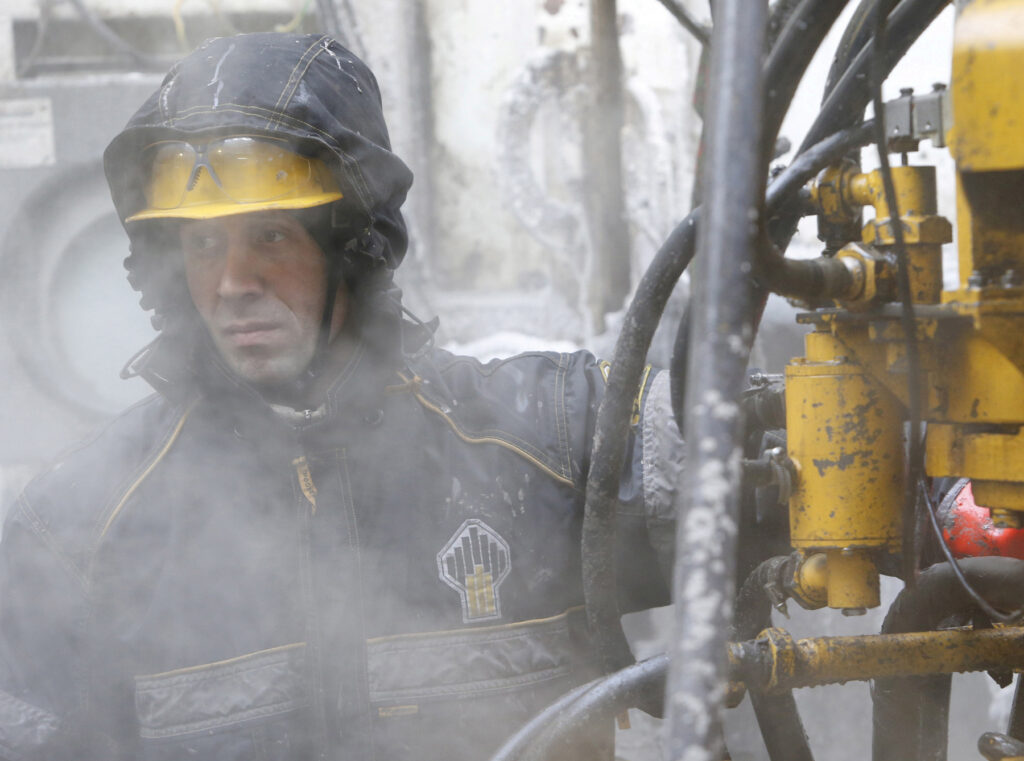Since 2014, Sechin has lobbied against any attempts to coordinate oil production cuts. He went so far as to leak a letter to Putin last February stating that OPEC+ cuts represented a strategic threat to Russia. As Russia restrained its output in lock-step with Saudi Arabia, the letter warned, US shale production would fill the gap. When Moscow signaled it was rejecting a new round of oil production cuts, Saudi Arabia opened the taps. After oil plunged below $30 a barrel, Moscow accepted an even harsher set of cuts. These were to stabilize prices and speed up market rebalancing in early April. From a reference of 11 million barrels per day (bpd), Russia agreed to cut 2.5 million, excluding condensate.
As the market sorted itself out and economies left the first wave of lockdowns, the cuts were eased by August. Russian production rose from 8.5 million bpd to about 9 million where it now lingers as oil exporters struggle with massive levels of demand uncertainty and second waves of COVID infections. US shale drillers have taken the hit as well from prices idled somewhere between $35 and $45 a barrel. The COVID shock raises a question for Russian oil: was Sechin right that US production “stole” market share that Russia could have held?
The Output Gap
Since 2001, Russia’s oil sector tax regime has been regressive. Whether it’s by an export duty or via Mineral Extraction Taxes (MET), the effective tax burden rises as oil prices rise, delivering more of profits that could be used to fund further investment to the budget. The effective tax rate on oil production from MET and duties – note that duties are now being eased out – is about 64%, and that’s before factoring in taxes on corporate profits. This may be lowered with tax breaks. But adding in expenses, 2019 estimates show that oil companies keep about 18% of the value of each oil barrel they sell if it trades anywhere between $30 and $100. While net profit does increase with higher prices, it does not do so significantly, whereas companies see quite little profit if oil prices fall below $30 a barrel.
This dynamic means that Russian oil companies aren’t that sensitive to higher prices above the $30-35 a barrel range and very sensitive to any price collapse below that threshold. Price increases typically lead to increases in drilling activity, but that’s eventually followed by a delayed increase in costs as harder-to-extract oil is drilled. The tax regime distorts this link because companies don’t see most of the profit gain above $35. Some of this is moderated by future demand and price expectations as well as lower production costs when the ruble is weaker. But since the price link with production increases is blunted and future prices rise as more expensive oil is drilled, Russian firms have to manage rising production costs at older fields alongside greenfield investment.
Looking at annual changes in Russian oil production since 2000, you can see the effect of the tax regime in action. A comparative view against Saudi Arabia, the United States, and the rest of the world is useful:
Increases in Russian oil output were strongest between 2000 and 2004 when prices, while rising, weren’t too high and production increases were led by firms like Yukos and Sibneft applying western production techniques to maximize output at fields that had been first developed in the Soviet period. As prices rose, those two companies were nationalized; the easy gains from Soviet-era fields were realized; production growth stalled. It even declined in 2008 despite prices supporting higher output.
Delayed Expectations
Since upstream investment generally operates on a decades-long timeframe for returns, the factors driving production increases are as important as whether increases take place. Russia’s oil production rose more than 3.2 million bpd during 2000-2004, though prices never climbed far beyond $35 a barrel and consensus forecasts did not predict the massive price increases of 2005-2008. When prices blew past $100 a barrel and stayed there after 2009, there was only a limited increase in the rate of production growth in Russia, though markets then assumed that prices at or above $100 a barrel were a “new normal.”
Between 2010 and the oil price shock that began in 2014, output only increased by a little over 700,000 bpd despite average prices of $100 a barrel or more. Exploration and drilling costs at newer fields were higher. There was a growing need to offset the depletion of older oil wells and fields in Western Siberia with investment into new fields — raising relative costs of production compared to enhancing recovery from existing assets.
Since 2016, production growth has been constrained by OPEC+ cuts. Relative gains from 2014 on – about another 700,000 bpd – were managed via cost reductions thanks to the devaluation of the ruble, an increase in horizontal drilling, and tax breaks won by Rosneft and Gazpromneft that are now under strain from more recent tax revisions. Excluding early increases when prices weren’t very high, Russian output growth only met 12% of global demand growth from 2004 to 2019. The fiscal regime, geology, and geography undermined increases in investment into newer production and increases in drilling activity outside of existing assets and satellite fields. Russian firms may be keen to invest into new production once OPEC+ cuts are lifted, but past performance suggests that the tax burden acts as a brake on production growth when prices are favorable.
The argument that the domestic political climate hinders investment plans is unconvincing. Even the largest firms able to exert their own will have not invested more. Lukoil has consciously focused on maximizing return per barrel over net production growth. Rosneft – the sector’s biggest player – has relied on acquiring developed or partially developed assets rather than greenfield investment. Sechin’s evangelical turn towards avoiding any production restraint aligns with the fact that he’s run out of large upstream acquisition targets developed by others. Conventional oil investments take time, but the tax regime disincentivized large projects once smaller, more nimble and efficient operators developing the biggest finds were acquired.
Event Horizon
As noted above, time horizons for investment into oilfields matter a great deal. Since a conventional oilfield realizes its returns over several decades, long-term expectations and fiscal regimes matter a great deal more than where the oil price is today. As we’ve seen, assumptions about high prices in an environment where demand was still growing presaged a large increase in Russian output, but delayed by a half decade and was only delivered in a price crash before being reined in by OPEC+ cuts. Arguably sustained high prices would have led to greater gains with various Arctic projects; but high costs and fiscal conditions would still slowdown international firms looking to maximize returns on investment. Offshore projects in the Arctic would have taken years to reach production and were high-risk because the upfront costs make it very difficult to idle wells in case of a price shock or demand shock. Shale, however, is a different beast.
The average fracked well for US shale producers produces almost all its oil in the first 48 days of production. For that reason, shale production is far more responsive to current prices than longer-term expectations. Historically, shale has required sky-high prices to be competitive. They were from 2010-2014 when US output grew by over 4.5 million bpd. The price crash in 2014-2015 led to a massive spike in bankruptcies in 2016, but companies adapted by aggressively cutting costs. By 2020, they could viably keep producing under $45 or even $40 a barrel in many instances. Output from 2015-2019 rose over 5.2 million bpd after absorbing initial losses. The short-term cycle to realize a profit off of a shale project combined with the relatively low costs of junk debt issuances in the US. This meant even when firms failed to generate positive cashflows, they could finance output and keep drilling.
Most of the shale output in the US is coming from older acreage now being revived using newer production techniques or else with a large number of wells that have been drilled but not completed. This means that firms don’t just react quickly to price changes. They can afford to preemptively drill to ramp up production quickly. Russia’s actually copied this approach during this year so that it can do the same once OPEC+ cuts end. Unless demand comes back strong and supply elsewhere falls significantly, that will crash future prices.
In theory, Sechin is correct. In practice, he’s completely missed the mark. Conventional oil output traditionally operates in price cycles with peaks and troughs balancing out returns on investment. Shale broke the traditional price, supply, and demand cycle. While conceivable that Russian oil firms could have cranked up output after 2010, they’ve been slow to move in response to higher prices, are highly sensitive to price collapses on a fragile market, and require more expensive production for future greenfield expansions and have slowly rising brownfield production costs. All this comes before considering that lower oil prices hurt the broader Russian economy.










